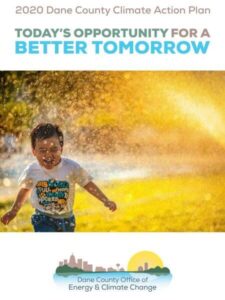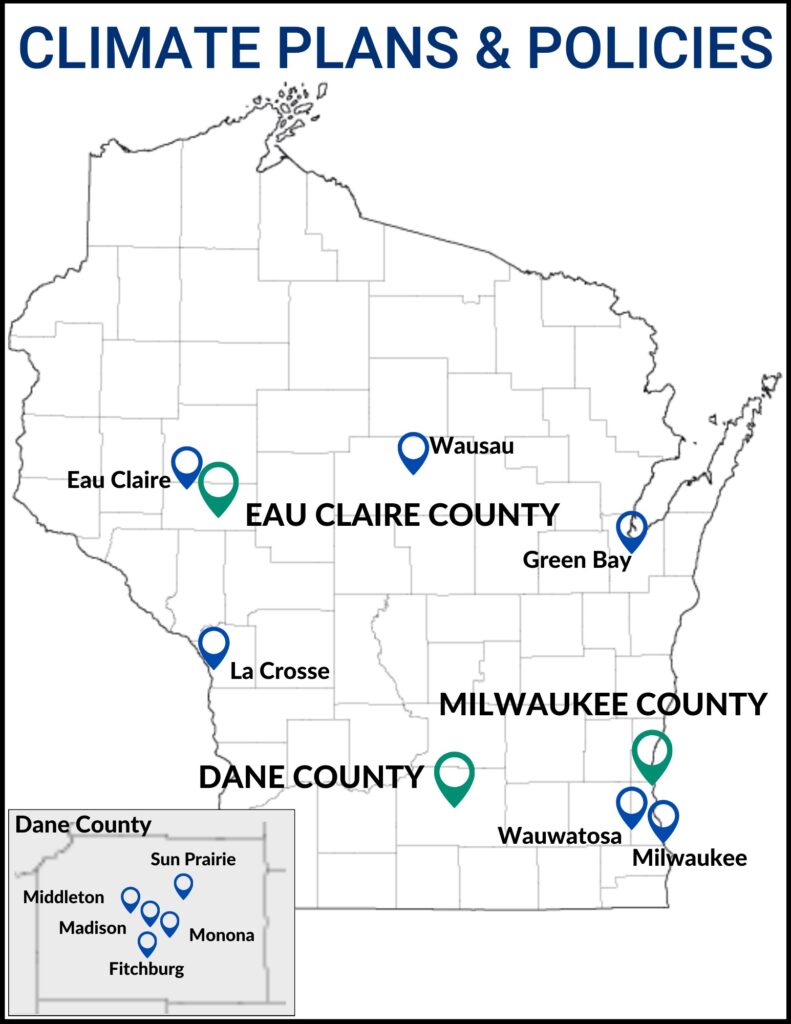Local Climate Action in Wisconsin Examples
A growing number of local governments in Wisconsin are adopting plans and policies to address climate change. Below is a comprehensive list of local climate plans and policies in Wisconsin with a summary of each and link to the full documents. If your community has adopted a climate plan or policy not on this list, please contact us.
Climate Action Plan – adopted April 2020
Guiding Principles:
- Equity/Justice
- Economic Benefits
- Health Benefits
- Resiliency/Security
- Bridging the Urban/Rural Divide
- Ecosystem Benefits
Climate Action categories:
- Energy Efficiency
- Buildings
- Transportation & Land Use
- Renewable Energy Production
- Agriculture & Forestry
- Water Energy Nexus
- Waste Materials & the Circular Economy
- Finance Solutions
- Cross-Sector solutions
More than 100 recommendations for reaching climate goals
Ho-Chunk Introduction
Equity & Justice is the first guiding principle in the document, cites the following:
- 2013 Race to Equity report
- Public health data
- “The Spirit Level: Why Greater Equality Makes Societies Stronger” by Richard Wilkinson and Kate Pickett
- Healthy Wisconsin Leadership Institute
- RE-AMP
- “Equitable and Just National Climate Platform” (2019)
- NAACP tool kit
- National Association of Climate Resilience Planners tool kit
- Acknowledgment that OECC fell short of diversity goals in developing CAP
Dane County Office of Energy & Climate Change (OECC) worked with representatives from 38 organizations and 75 other individuals.
Dane County Climate Action Plan includes steps to continue public engagement throughout implementation:
- Broad awareness-raising
- Diverse Engagement Initiatives
- Awards & storytelling
The Plan cites resources for inclusive engagement and outreach:
- Climate Reality Project
- Alliance for Climate Education
- Yale Program on Climate Change Communications
- Climate Generation
Overall goal to reduce GHG to 50% of 2010 levels by 2030
OECC contracted with Evelyn Wright and Amit Kanudia to establish baseline GHG inventory and model policy timelines to 2030 and 2050 using 100 mitigation strategies in 10 categories outlined in the Plan:
- VMT reduction
- Increase EV sales
- Increase use of Biogas
- Increase solar-generated power
- Increase wind-generated power
- Decrease per capita water demand
- Increase energy efficiency
- Improve building performance
- Increase use of heat pumps
- Increase use of manure digesters
Renewable Energy Action Plan – adopted February 2020
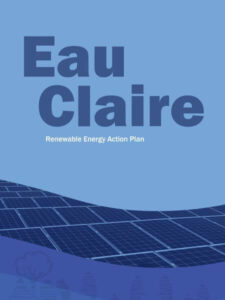
Goal: 100% renewable energy and carbon neutrality by 2050.
Guiding Principles:
- Equity & Inclusiveness
- Economic Development
- Ecosystem Stewardship
Impact Areas (2020-2030):
- Local Biodiversity
- Residents & Homes
- Businesses & Institutions
- Transportation
- Waste
The plan includes near-term strategies (2020-2030) with detailed metrics for each impact area for the community and municipal operations. Appendix B outlines long-term initiatives (2030-2050) with several strategies to achieve the goal of zero emissions by the target date of 2050. Accompanying action plans include the Electric Vehicle Roadmap, the Net Zero Energy Building Guide, and the Solar-Ready Guide which were developed in conjunction with REAP.
“Those with less or no ability should not be sidelined or cast to circumstances that undermine their basic needs. However, a plan can only go so far – equity and other principles should be intentionally designed into strategies during implementation.” (p. 12)
Equity & Inclusiveness: Our work will engage and support the entire community, increasing benefits for under-resourced populations. (p. 12)
Plan made with 40 stakeholders on the steering committee; names and institutions are listed on the Acknowledgements page (p. 4). Plan was developed over 5 workshops in a 6-month period in 2019. Public input was gathered in a temporary art installation. Included a Land Recognition Statement: “We acknowledge and honor that the land the city of Eau Claire occupies is the sacred and ancestral lands of the Ojibwe, Dakota, and other Indigenous Peoples.”
Equity metrics (example)
- Goal: By 2030, 100% of new affordable housing development takes advantage of an energy efficiency or renewable energy program or project
- Metric: Number of developments participating in programs or project
- Critical Pathways: Local Biodiversity – increase carbon sequestration by 1%/year in urban forest
- Residents & Homes – Achieve 2% electricity savings and 1.4% natural gas savings per year; convert 200 households to renewable electricity and 20 to renewable heat per year.
- Businesses & Institutions – Achieve 3% electricity savings and 1.5% natural gas savings; convert 15 new businesses to renewable electricity and 5 to renewable heat per year.
- Transportation – Increase electric vehicles (EVs) to 10% of vehicle miles traveled and increase vehicle occupancy to 2 people.
- Waste – Divert 50% of organic waste and 50% of construction and demolition waste streams from landfills by 2030.
100% Renewable Energy Resolution – adopted April 2019
April 16, 2019, County Board Resolution 19-20/003 committing to 100% renewable energy by 2050 and dedicating $10,000 for planning passed with 25 ayes, 1 no, and 3 absent.
Public meeting process.
Clean Energy Resolution – adopted February 2019
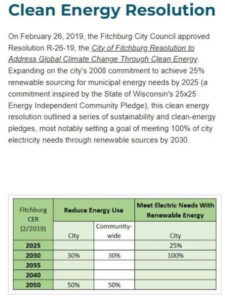
On February 26, 2019, the City of Fitchburg approved Resolution R-26-19. Goal: 100% electricity from renewable energy sources by 2030.
“WHEREAS, low-income and vulnerable residents are often most burdened by the cost of energy and are the most susceptible to public health impacts of continued reliance on fossil fuels (especially the incidence of asthma and other respiratory illnesses related to air pollution on high-temperature days); and the City is committed to energy efficiency and renewables, electrified transportation, fair utility rates, and employment opportunities.”
Public meeting process.
Existing inventory:
- Municipal projects to install solar and geothermal systems on public buildings
- Energy efficiency initiatives
- Intervention in 2014 MGE rate case
Healthy Neighborhoods Initiative is focused on implementing equity, diversity, and sustainable education, employment, housing, environment, etc. in neighborhoods.
Future metrics:
- City: 25% electricity from renewables by 2025, 100% by 2030
- Community: reduction of 30% per capita by 2030, 50% per capita by 2050
- Prioritize programs that benefit low-income residents
- Prioritize community-based renewable sources
- Prioritize collaboration w/ other government entities
- Prioritize microgrids
- Develop Energy and Water Plan
Clean Energy Plan – adopted December 2023
On December 5, 2023, the Green Bay city council approved the Clean Energy Plan. The Plan follows a 2021 resolution to achieve 100% clean energy and carbon neutrality by 2050.
The Plan includes: an inventory of emissions; interim targets to reach by 2030 in buildings, electricity, and transportation; 6 long-term focus areas in buildings, transportation, clean electricity, education, advocacy, & urban tree canopy; steps for implementation and financing.
None.
Community survey administered from January 2023 – April 2023.
Community open house held in July 2023 with materials provided in Hmong and Spanish.
The Plan includes detailed metrics for emissions, upfront costs, and cost savings over time.
No metrics are provided that focus on equity.
Climate Action Plan – adopted January 2023
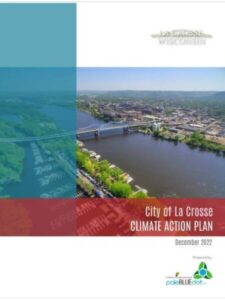
Goal: Reduce community-wide GHG by 40-50% from 2019 levels by 2030 and achieve carbon neutrality by 2050.
The Plan addresses 9 sectors of GHG emissions through 41 strategies supported by 281 actions over an 8-year implementation timeframe.
The sectors are grouped into the following categories: Transportation & Mobility, Buildings & Energy, Land Use & Housing, Health & Safety.
- Introduction includes statement on equity and inclusion in CAP actions.
- Includes land acknowledgment
- Frequent references to groups of people who are historically marginalized and will feel the greatest impacts from climate change.
- Youth engagement component.
- Equity-focused Community Engagement
- 11-month timeframe
- 46 planning team members
- 15 community partner groups
- 722 community members gave input
- 5 foundational research documents
- 2 opportunities for online surveys
Reduce community-wide GHG by 40-50% from 2019 levels by 2030 and achieve carbon neutrality by 2050.
The Plan includes many specific metrics to reach climate goals.
Each section includes a highlighted portion titled “Equity considerations” that describes how the metrics will impact frontline, low-income, and vulnerable communities.
Specific Equity Metrics:
- Reduce share of population living in high-energy poverty from 16.4% to 11.4% by 2050
- Improve resilience of community’s water, wastewater, and stormwater infrastructure to flooding, particularly in high-risk areas.
- Increase production of and access to local food, particularly serving low-income and food-insecure individuals.
- Reduce food waste and hunger, and achieve 50% reduction in food insecurity community-wide by 2030.
- Assist the community’s vulnerable population in preparing for and mitigating local climate change impacts.
100% Renewable Madison – adopted November 2018
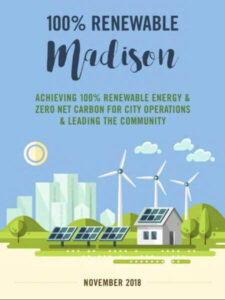
Goal of this report:
- Report recent sustainability successes from the City of Madison local government operations and the greater Madison area community
- Provide an overview of three time-based scenarios for Madison’s low-carbon future
- Provide suggestions and recommendations to accelerate progress toward reaching 100% renewable energy and zero net carbon goals for local government
Powering city operations with 100% renewable energy will enable city officials to solve community-wide economic, environmental and social challenges. City officials will be able to accomplish city policy objectives such as job creation, promoting racial and social justice, contributing to long-term public health vitality through improved air quality, and resilience to natural crises.
- Continue to expand education through outreach and programs such as MadiSUN
- MadiSUN is a nonprofit organization that provides group buys for homes, solar for businesses, and solar loan programs
- Madison will continue to expand funding for MadiSUN and consider funding for additional community engagement initiatives, such as crowdsourcing or competitions
The government can achieve 100% renewable energy between 2020 and 2030 by:
- Reduce energy demand from local government operations through energy efficiency and behavioral measures
- Supply electricity through renewable energy and to the extent possible, generating renewable energy locally
- Supplying remaining energy needs from renewable energy credits (REC) and carbon offsets as a bridge strategy, while local governments continue to invest in efficient transportation, energy efficiency, and renewable energy as opportunities arise
Climate Foward Agenda – unveiled April 2021

Madison is looking to change current practices and make a dent in emissions to protect health, economy, environment and quality of life. Madison aims to (within two years of this announcement):
1. Continue to lead by example with current climate change initiatives
2. Bring Madison building stock into the 21st century
3. Continue to invest in transit and other low-carbon transportation modes
4. Invest in community and grow a climate-friendly economy
15 ways Madison is advancing this agenda to reduce greenhouse gas emissions, advance environmental justice, and improve resilience to climate change:
- Using clean energy for city operations
- Installing solar at city facilities
- Providing green workforce training through GreenPower Program
- Spreading solar in the community
- Leading on green buildings
- Investing in energy efficiency for naturally occurring affordable housing
- Decarbonizing our fleet
- Providing all-electric bus rapid transit (BRT)
- Growing sustainable transportation options
- Partnering for regional, statewide and national action
- Growing climate capacity
- Reducing flood risk across Madison neighborhoods
- Prioritizing climate and equity in city purchasing
- Converting our streetlights to LEDS
- Requiring sustainability features in our affordable housing funding
In order to prioritize climate and equity in city purchasing, a citywide RFI was issued to help identify and do business with a diverse pool of vendors, business owners, local businesses, and entrepreneurs.
Madison will strengthen linkages between public health, workforce, and climate-friendly community. A community climate grant program will be launched to help organizations reduce emissions and increase resilience
- Constructed 13 LEED-certified green buildings
- Installed 19 MW of off site solar energy
- Purchased 60 electric, 108 hybrid electric, 470 low-carbon fuel fleet vehicles and equipment
- Built 6 solar-powered EV charging stations
- The city receives and manages $50-75 million in federal and state grant awards annually and is working to ensure Madison benefits from federal climate investments.
Draft Sustainability Plan – updated March 2023 (not publicly available yet)
Climate Forward Madison at-a-glance
The goal is to reflect and articulate new and relevant sustainability priorities in order to leverage action the city has taken, and inform the public about Madison’s sustainability goals and efforts. The 7 topic areas and 24 goals include:
- 1. Quality and affordable housing:
- Increase availability of affordable housing
- Expand and create city policies to support energy efficiency, sustainability and removal of environmental toxins in new and existing affordable rental housing
- 2. Resilient city design and infrastructure:
- Provide equitable access to parkland, lakes and other natural areas as well as nature-based recreation, education and wellness programming offered by the City and its partners
- Protect and increase access to infill, neighborhood-scale sustainable farming and community gardening
- Facilitate compact, transit-oriented development that supports walking, biking and transit use; reduces traffic and greenhouse gas emissions, enhances livability, improves environmental quality and public health
- 3. Renewable energy and decarbonization:
- Increase resilience to climate change impacts including heat waves, storms and flooding
- Reduce greenhouse gas emissions from city facilities and buildings by 55% from 2030 to 2018
- Reduce greenhouse gas emissions from private facilities and buildings to achieve the city’s goals of reaching zero net emissions community-wide by 2050
- 4. Sustainable transportation:
- Reduce greenhouse gas emissions from city vehicles and equipment by 90%
- Improve access to low-cost low carbon transportation citywide
- Reduce vehicles miles traveled by 15% community-wide
- 5. Clean and abundant water:
- Ensure our surface and drinking waters remain clean by reducing existing sources of contamination
- Expand water conservation efforts to reduce peak load and annual water use from 10% from 2020 levels by 2030
- 6. Zero waste:
- Reduce amount of waste in landfills by 50% by 2050 and 90% by 2040
- 7. Vibrant green economy
- Preserve and restore natural urban areas, with a focus on providing equitable access for residents
- Implement integrated pest management practices to minimize pesticide use
- Equitably expand urban tree canopy coverage from current 23% to 40% by 2030
- Support environmentally-sustainable private business growth, operations, and practices.
- Leverage City financing tools to advance environmentally sustainable and climate-resilient buildings, business development, and investments in the community.
- Work with partners to attract and support the development of new businesses focused on green- and climate-friendly services or products, especially minority and women-owned businesses.
- Develop a green workforce and create equitable access to green jobs with a living wage.
The city is working toward reaching a vision of sustainability and equity by narrowing on a priority set of attainable, trackable goals and actions.
The city will prioritize investments to accomplish a set of sustainability, climate or environmental justice priorities defined in collaboration with the community. Madison, along with Dane County collaborates with leaders and staff from municipalities to share information and lessons learned on solar installation, green fleets and more in order to reduce carbon emissions at the pace and scale needed.
The City also will:
- Expand parkland, natural areas and protected shoreline through purchase of property or easements to improve public access, in alignment with the Parks and Open Space Plan
- Implement Transit-Oriented Development (TOD) Zoning along BRT and other existing and planned high-frequency transit service corridors to create development intensity minimums, reduce parking requirements, and support transit use
- Assess the location and characteristics of urban heat islands and populations sensitive to extreme heat in the City of Madison, and collaboratively develop and implement equitable heat resilience strategies to reduce the magnitude of urban heat islands and improve community adaptive capacity to extreme heat events.
- Expand the availability of electric bike and bike rideshare stations into areas underserved by current services.
The city receives and manages $50-75 million in federal and state grant awards annually and is working to ensure Madison benefits from federal climate investments. The city will meet 100% of electricity demand for city operations by 2030. Madison will leverage City purchasing power to support products and services that reduce the City’s negative impact on the environment and support a circular economy.
In addition, the City will:
- Prioritize recommendations from the 2019 Urban Forestry Task Force Report and implement them in phases with completion by 2025. These policies and programs should be developed in conjunction with neighborhood groups, with particular attention paid to improving canopy coverage in underserved neighborhoods.
- Continue to partner with and support local organizations that assist the business community to adopt environmentally-sustainable and climate-resilient business practices, especially the BIPOC and historically underrepresented business community.
- Support and encourage minority business ownership in trades and industries that focus on green and climate-friendly services and products.
- Support training opportunities in the trades and other in-demand careers related to renewable energy and sustainability.
Building Energy Saving Program (BESP) – adopted March 2023
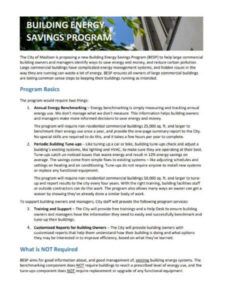
The BESP requires owners of large nonresidential commercial buildings to annually track their energy use through “energy benchmarking” and to tune up their building’s energy systems every four years. Tune-ups check and adjust a building’s existing systems, like lighting and HVAC, to make sure they are operating at their best and not wasting energy.
City staff worked with alders, the business community, non-profits, building energy and management experts, and others for two years to develop the program. With the policy in place, City staff will continue to collaborate with the Madison community to develop program guidance and provide education, training, and support for building owners and managers. Both actions will be phased in over time, with the first benchmarking deadline in June 2024 and the first tune-up deadline in October 2025.
The BESP could cut carbon pollution by more than 91,000 tons per year, the same impact as taking 18,000 cars off the road.
The program would cover about 680 buildings 25,000 square feet or larger, including about 310 that are 50,000 square feet or larger.
Sustainable City Plan 2022-2024 – adopted August 2022
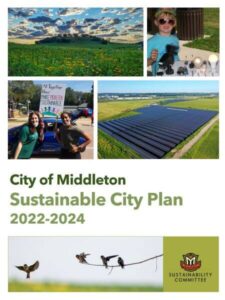
Sustainable City Plan: 2022-2024
Energy is the focus of the plan with an overall goal of 100% clean energy by 2050, with interim targets by 2030:
- 15% reduction by city
- 10% reduction in community
- 80% electricity & 66% total energy from renewable sources by city
- 66% electricity & 21% total energy from renewable sources for community
The Plan is divided into 7 Action areas: 1) Energy (this is the primary focus and includes the most detailed action steps); 2) Greenhouse Gas Emissions; 3) Food; 4) Land Use; 5) Transportation; 6) Waste Generation & Management; 7) Water
The Plan concludes with a set of recommendations for city council and city staff to adopt in order to further sustainability goals. One recommendation specifically tied to equity is to supplement the city’s Health in All Policies commitment with an environmental justice policy.
Comprehensive Plan 2021 Vision Statement: City of Middleton is a sustainable, urban community with an exceptional quality of life that is rooted in environmental stewardship. We are a thriving safe community accessible to all, and we celebrate diversity and equitable opportunities for all people. Middleton’s City Comprehensive Plan of 2021 focuses on land use, transportation, housing, economic development, character, green city, governance and partnerships, and implementation.
Values:
- Goals, priorities, & actions will reflect input from the community.
- Process will be transparent with updates online & at Sustainability Committee meetings
- Process and plan will be viewed through DEI lens to assure sustainability for all.
- Sustainable City Plan is written for a public audience.
- Plan will highlight success stories to help neighbors learn from each other.
Additionally, the city will maintain strong partnerships among departments and with outside organizations to maintain community engagement.
The community values of Middleton listed in the City’s Comprehensive Plan are community, sustainability, equity, health, accessibility, innovation, and resiliency.
- Draft plan presented for review in June 2022
- 2 public input sessions (one live, one virtual)
- Online survey using Polco
- Plan will be reviewed and updated on a yearly basis with opportunities for residents, organizations, and businesses to get involved.
The Plan includes measures of progress for the areas of Energy and Greenhouse Gas Emissions only. Some metrics include tracking specific numbers (e.g. number of installations of a particular technology) and other metrics are measured by putting systems in place (e.g. microgrids) to enhance sustainability measures.
Equity metrics:
- ENERGY. Administer programs for energy efficiency & renewable energy with priority for LI households. Equity metrics: number of dwelling units converted, reduction in energy usage, % electricity from renewable sources.
- FOOD. Support school & community gardens and food pantries to alleviate food insecurity. No metrics were given.
Climate & Equity Plan – adopted March 2023

The plan features areas of focus called the “10 Big Ideas.” These include:
- Green jobs accelerator
- Aims to create clear pathways to increase the number of people of color employed in families supporting green jobs.
- Healthy home energy updates
- Make weatherization and renewable energy retrofits more affordable as part of holistic housing improvements that also address lead-based paint and other health hazards.
- New net-zero energy homes
- Aims to build healthy, affordable, net-zero energy homes on Milwaukee’s scattered vacant lots. The homes will be designed to be all-electric, affordable, durable, and fit within the architectural character of the city’s neighborhoods.
- Commercial building energy benchmarking and building performance standards
- Requiring large commercial building owners to annually track and report on their energy use and develop longer-term building performance standards to gradually reduce greenhouse gas emissions from commercial buildings.
- People-centered Transportation and urban design
- Aims to help people drive less by improving and expanding city-wide public and active transportation options and creating thriving communities where people live, work and play.
- Electrify transportation
- Aims to build a network of publicly accessible electric vehicle charging stations, increasing EV adoption rates through public outreach, and transitioning municipal fleets to EVs, hybrids and other low-emission vehicles.
- Greening the electric grid
- Plans to transition the electric grid to carbon-free sources of energy through advocacy for better renewable energy from new, utility-scale projects and expansion of rooftop solar in the city.
- Protect and restore nature in the city
- Aims to protect existing natural areas and increase the amount of green space and trees on private and public property through the expansion of the Green and Healthy Schools Program and removal of excess asphalt in commercial parking lots that also contribute to urban heat islands.
- Waste reduction and sustainable consumption
- Aims to redirect surplus food to feed people and reduce waste through a new FEED partnership, as well as reducing plastic pollution and exploring lower carbon cement.
- Resilience ambassadors
- Aims to partner with trusted neighborhood-based organizations to connect with underserved communities with available tools and resources to make their homes and neighborhoods more resilient to climate change.
The Plan recognizes that “while climate change affects us all, it does not do so equally. Underserved communities bear the brunt of most impacts of climate change, like urban heat islands and flooding.”
“Environmental justice is only possible if income, race, ethnicity, and place of residence does not determine the burden people face from climate change.”
The Task Force worked to include communities of color on working groups and in public conversations about the Plan. ECO also hired a fellow to support robust community engagement on the plan.
During the two years of creating the plan, there were: over 300 community leaders and organizations that worked on the plan, 649 survey responses, 80 local experts collaborating through working groups, and 19 public events to disseminate the plan and gain feedback on it.
Specific metrics address greenhouse gas emission reductions and equity targets. Additional metrics will focus on measuring the 10 Big Ideas.
- Green jobs accelerator
- The city plans to create green jobs that pay at least 40,000 per year at the entry-level
- 40% of green jobs will be held by people of color
- Community-wide measures will be tracked by:
- Employment Rate by Race and Gender (Census)
- Median Household Income by Race (Census)
- Median Hourly Wage Rate by Race and Gender (BLS data)
- Healthy home energy upgrades
- New Net Zero Energy Homes will result in 1,250 homes being upgraded or built every year until 2050
- Improve standard of living for 85,000 people
- New net-zero energy homes
- With future climate migration and the Mayor’s goal to have Milwaukee be a city of 1 million people, there is an urgent need for affordable and sustainable housing. New homes will be built with triple-bottom-line sustainability to (1) reduce environmental impact, (2) be affordable, and (3) provide added health and social benefits to the residents.
- The project envisions supporting a new factory in Milwaukee that constructs modular housing components year-round
- Will result in a model for infill housing in Milwaukee’s neighborhoods, while also mitigating flood risk.
- Commercial building energy benchmarking and building performance standards
- Development of new benchmark ordinance through a stakeholder process that would require large commercial buildings annually to report their energy use
- Based on other cities, benchmark policies result in a 2.4% average annual energy saving improvement over the first 3 years for a total of 7.2% GHG emissions inventory for Milwaukee predict a decrease in 54,536 tons annually
- People-centered transportation and urban design
- Reduce daily average VMT by 20% from 24.4 miles per capita to 19.5
- Per capita vehicle miles will decrease by 30% in 2050
- Electrify transportation
- To achieve that goal, 50% of new vehicles in Milwaukee will need to be EVs by 2030 and 30% of new heavy-duty vehicles will need to be EVs.
- Greening the electric grid
- Streamlining the permitting process for installing solar energy systems
- Financing solar projects through Milwaukee Shines loans
- Expanding workforce partnerships to develop Milwaukee’s solar workforce
- Protect and restore nature in the city
- Nature in the City approach is organized by a four-pronged approach
- Protect environmentally sensitive lands, targeting key acquisitions
- Expand the green and healthy schoolyard redevelopment program, noting particular benefits for areas of the city that already experience higher levels of poverty, violence, and stress
- Implement the Branch Out Milwaukee Campaign to maintain and expand Milwaukee’s tree canopy and employ residents
- Incentivize green cooling commercial lots, prioritizing low-income neighborhoods
- Waste reduction and sustainable consumption
- A 20% reduction in solid waste generated by 2025 and 25% reduction by 2030
- City will continue the 100,000 in annual budget allocations for Fresh Food
- Access and use a portion to fund FEED MKE
- Resilience ambassadors
- Goal of capturing 36 million gallons of water from each rainfall in green infrastructure by 2030
- Manage the 500-year floodplain for new development in Milwaukee County
Climate Action 2050 Plan – still in development
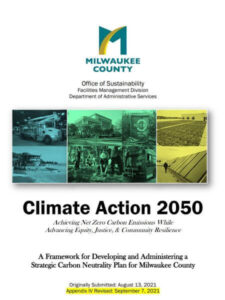
Climate Action 2050 aims to reduce carbon emissions from county operations while adapting to climate change. Additionally, it serves as a roadmap to:
- Achieve ‘carbon neutrality, or zero net carbon emissions in county operations.
- Improve the resilience of county operations and the community to climate change.
- Align Milwaukee County’s climate initiatives with its vision to become the healthiest county in Wisconsin by achieving racial equity.
Plan aims to achieve racial equity and improve health outcomes. Focuses efforts on those disproportionately impacted by climate change.
The Climate Action Plan will:
- Prioritize projects that produce co-benefits to populations who are disproportionately impacted by climate change.
- Identify and involve internal and external stakeholders.
- Align with Milwaukee County’s core functions, missions, and priorities.
- Leverage existing plans, initiatives, and resources to build a shared commitment to climate action across county departments, community partners, and the general public.
1. County emissions: Provides estimates of carbon emissions from 2019-21 Milwaukee County government operations.
2. Community Engagement Strategy: December 2022 report to the Sustainability Task Force that describes how the climate action planning process will inform and engage diverse Milwaukee County stakeholders, especially populations disproportionately impacted by climate change.
City Sustainability Plan – adopted March 2012
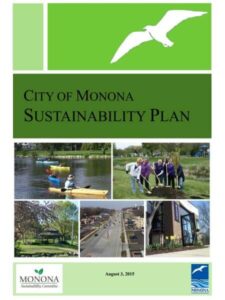
Sets targets for 2025:
Six Focus Areas:
- General Sustainability
- Land Use
- Water
- Energy
- Transportation
- Solid Waste
2 categories of objectives:
- Community
- Municipal
Annual implementation plans to be developed in conjunction with city budget.
No explicit definition of equity or equity goals. However, the following language was used:
“…practicing sustainability means working to meet the needs of today’s residents and visitors without compromising the needs of future residents and visitors…” (from 1987 Report of the World Commission on Environmental Development)
“The MSP [Monona Sustainability Plan] recognizes that all municipal decisions are made within the context of the nesting of economic systems within social systems within the environmental system. Finding solutions that respect both current and future community members’ needs and that are resilient to changing circumstances presents both challenges and opportunities. These can best be met when all systems involved are carefully considered, and when decision-making is informed, collaborative, flexible, and creative.” (p. 10)
Equity is addressed via the Green Tier Legacy Communities annual report and scoresheet.
- September 2013 forum with representatives from all city boards, committees, and commissions
- October 2013 public meeting
- Public online survey for feedback on first draft
- November 2014 public meeting with plan commission, both sustainability plan and comprehensive plan were presented with offer for input
- Ongoing opportunities for stakeholder feedback during implementation and evaluation.
- Annual implementation plans to be developed in conjunction with city budget process provide opportunity for public input.
Baseline data from 2012 (when applicable), targets for 2025.
Task Force Report – adopted September 2021

Vision Statement: “The City of Sun Prairie will collaborate with its citizens to create and expand sustainability practices while always recognizing the interdependence of environmental quality, economic resiliency and growth, and social equity. Our mission is to promote and enable our community to embrace a culture that is inclusive, safe, resilient, and sustainable.”
Goals divided into 3 focus areas and 9 impact areas:
- Planet (Agricultural/Natural/Cultural Resources, Land Use, Transportation)
- People (Housing, Utilities & Community Facilities, Community Engagement & Social Justice, Lifestyle, Housing)
- Profit (Economic Development)
Many recommendations are included, and there is a distinction between municipal actions and community actions.
There is no specific definition of equity, but the Task Force report defines
“sustainability” as: Balancing the demands and impacts of economic stability, environmental protection, and social equity across our community now and in the future.
Statement on Equity
Our guiding principles on the values of Diversity, Equity, and Inclusion: Sun Prairie is committed to advancing equity, honoring our diverse identity, and creating an inclusive culture. These serve as our guiding principles every day in all that we do.
Equitable Processes (Community Engagement)
The values of sustainability and equity are connected. The City of Sun Prairie is in the process of completing an Equity Audit that aims to assess our current city service delivery and make recommendations on how to improve equity in how we service the community. Although the report is not complete, the audit will provide insight and guidance to the organization on how to better engage the community. A portion of the Equity Audit will review efforts made around improving sustainability.
- Task Force comprised of City staff, elected officials, experts, community members met over the course of one year to develop report. Guest speakers from nonprofits and government offices presented at several Task Force meetings.
- An extensive survey was sent to city staff.
- Community Survey: statistically significant survey sent to 700 households to gauge support for various initiatives and ideas.
- Many recommendations include ongoing engagement and education opportunities for community members to understand sustainability initiatives by the city and learn how they can participate.
Several recommendations include metrics that are targeted equity initiatives. For most, the metric is not tied to a specific number:
- Financial assistance & incentives to LMI homeowners
- Financial assistance & incentives to housing providers for LMI households
- City will prioritize contracts with entities with fair and inclusive hiring practices
- Various community engagement, education, and outreach for sustainability initiatives
- City will develop DEI plan
- Various recommendations to expand access to fresh, local food
- Adopted HiAP
- Utility assistance & energy efficiency for LMI households
- Program established to address unhoused population
- Incentives and awards to local businesses who practice sustainability and equity
- Economic incentives for minority and/or woman-owned businesses
Environmental Justice Resolution – adopted September 2021
Environmental justice aims to address environmental challenges by being proactive with a long history of targeting untenable practices. The city aims to ensure all citizens and visitors can equally be protected against environmental and health hazards, and have equal access to the decision-making processes to have a healthy environment in which to live, learn and work. Equitable development improves public involvement, supports collaborative problem solving and makes a visible difference in communities that are underserved, under-resourced and overburdened.
WHEREAS, Environmental Justice is defined by the United States Environmental Protection Agency as the fair treatment and meaningful involvement of all people, regardless of race, color, national origin, or income, with respect to the development, implementation and enforcement of environmental laws, regulations and policies.
WHEREAS, BE IT RESOLVED by the City Council of the City of Wausau, Marathon County, Wisconsin that the City of Wausau will use environmental justice principles during city policymaking and develop a plan with clear goals for meaningful public engagement. The plan should ensure that those responsible for decisions that could affect the quality of life for residents, citizens, workers and employers, visitors, neighborhoods and our City at large hear and consider meaningful, timely, inclusive, accessible public comment, with the intention of being responsive to that public input.
The Resolution commits the City to:
- Equitable public engagement process
- Develop and maintain an active GIS based inventory of environmental justice areas in Wausau by using the EPA’s EJSCREEN, a Screening and Mapping tool.
Clean Energy Resolution – adopted March 2023
The resolution commits the City of Wausau to “develop a municipal energy plan with the goal of moving City government operations to a more secure, and 100% clean energy by 2050.” The measure also calls for determining the baseline level of energy use and greenhouse gas emissions in city government operations. Additionally, the city resolves to provide resources and information to residents and businesses to support them in the transition to a cleaner energy future.
Wasau established an Environmental Justice Resolution to specifically target equity initiatives and challenges.
The city resolves to provide resources and information to residents and businesses to support them in the transition to a cleaner future.
The city focuses on data and citizen-driven initiatives. The city is working to establish a baseline at the Public Health and Safety Committee to see where the city is at on greenhouse gas emissions and bring a status report back to the council by the end of the year.
Energy Resolution – adopted October 2020
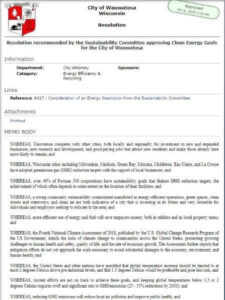
Resolution approved October 6, 2020 by a vote of 8-0.
- Commitment to 50% reduction of 2010 emissions by 2030.
- Commitment to 25% municipal energy from renewable sources by 2025.
- Commitment to achieve city and community carbon neutrality by 2050.
- Commitment to track progress and guide community to reach goals.
“WHEREAS, the city envisions a climate and energy planning process that will reflect community values and stakeholder participation to develop low carbon means to reach these goals. Stakeholders include residents of all income levels and backgrounds, businesses, utilities, the educational community, institutions, the building and construction sector, transportation providers, waste companies, and many others;”
WHEREAS, the City envisions a climate and energy planning process that will reflect community values and stakeholder participation to develop low-carbon means to reach these goals. Stakeholders include residents of all income levels and backgrounds, businesses, utilities, the educational community, institutions, the building and construction sector, transportation providers, waste companies and many others.
The City has a Sustainability Committee that is comprised of citizens that advise City Council
- Achieve municipal and community carbon neutrality by 2050.
- Through efficiency and the use of clean energy, reduce municipal emissions to 50% of 2010 levels by 2030, in line with global goals.
- Guide the community on pre-2050 efficiency and clean energy targets that are in line with global goals, and suggest paths to achieving those targets in households and institutions.
- Track progress by collecting and publishing basic data on municipal and community energy use annually.
